Russia
The East Slavs emerged as a recognisable group in Europe between the 3rd and 8th centuries AD. The medieval state of Rus' arose in the 9th century. In 988, it adopted Orthodox Christianity from the Byzantine Empire, beginning the synthesis of Byzantine and Slavic cultures that defined Russian culture for the next millennium. Rus' ultimately disintegrated until it was finally reunified by the Grand Duchy of Moscow in the 15th century. By the 18th century, the nation had greatly expanded through conquest, annexation, and exploration to become the Russian Empire, the third-largest empire in history. Following the Russian Revolution, the Russian SFSR became the largest and leading constituent of the Soviet Union, the world's first constitutionally socialist state, which was a one-party state throughout most of its existence. The Soviet Union played a decisive role in the Allied victory in World War II, and emerged as a superpower and rival to the United States during the Cold War. The Soviet era saw some of the most significant technological achievements of the 20th century, including the world's first human-made satellite and the launching of the first human in space. Following the dissolution of the Soviet Union in 1991, the Russian SFSR reconstituted itself as the Russian Federation. In the aftermath of the constitutional crisis of 1993, a new constitution was adopted, and Russia has since been governed as a federal semi-presidential republic. Vladimir Putin has dominated Russia's political system since 2000, and his government has been accused of authoritarianism, numerous human rights abuses, and corruption.
Russia is a great power, and is considered a potential superpower. It is ranked very high in the Human Development Index, with a universal healthcare system, and a free university education. Russia's economy is the world's eleventh-largest by nominal GDP and the sixth-largest by PPP. It is a recognised nuclear-weapons state, possessing the world's largest stockpile of nuclear weapons, with the world's second-most powerful military, and the fourth-highest military expenditure. Russia's extensive mineral and energy resources are the world's largest, and it is one of the leading producers of oil and natural gas globally. It is a permanent member of the United Nations Security Council, a member of the G20, the SCO, the Council of Europe, the APEC, the OSCE, the IIB and the WTO, as well as the leading member of the CIS, the CSTO, and the EAEU. Russia is also home to the ninth-greatest number of UNESCO World Heritage Sites.
- The story behind Russian dishes.
- Blini (Russian pancakes)
- Pelmeni.
- Beef Stroganoff.
- Syrniki.
- Kasha (Porridge)
- Borscht.
- Okroshka.
10 Top Tourist Attractions in Russia
The largest country in the world, Russia
offers a broad array of travel experiences, from treks up the slopes of
glacier-capped mountains to strolls along the shoreline of Earth’s
oldest lake. Historical sites and cultural activities in the country’s
great cities abound as well. Whether you’re exploring the grounds of
Moscow’s Kremlin or wandering through the steppes of Mongolia, a visit
to Russia is an adventure not soon forgotten. These top tourists attractions in Russia can inspire a great Russian itinerary for a memorable trip.
The largest country in the world, Russia offers a broad array of travel experiences, from treks up the slopes of glacier-capped mountains to strolls along the shoreline of Earth’s oldest lake. Historical sites and cultural activities in the country’s great cities abound as well. Whether you’re exploring the grounds of Moscow’s Kremlin or wandering through the steppes of Mongolia, a visit to Russia is an adventure not soon forgotten. These top tourists attractions in Russia can inspire a great Russian itinerary for a memorable trip.
1. Trans-Siberian Railway

Part of the longest railway system in the world, the classic Trans-Siberian railway runs from Moscow to Vladivostok, a city near Russia’s borders with China and North Korea. Begun in 1891 by Tsar Alexander III and completed by his son, Tsar Nicholas II, in 1916, the line is known as the route of the tsars. Most travelers use the train as overnight accommodation from one destination to the next. The train features first-, second- and third-class sleepers, some with private bathrooms and showers.
2. Mount Elbrus

Mount Elbrus is located in the Caucasus Mountain Range in Southern
Russia. At 5,642 meters (18,510 ft), Elbrus is included as one of the
Seven Summits, the highest summits on each of the planet’s seven
continents, attracting both experienced and novice mountain climbers.
While the mountain was formed from a volcano, it is considered dormant,
with no recorded eruptions. A cable car system can take visitors as high
as 3,800 meters (12,500 ft), facilitating ascents to the summit.

Mount Elbrus is located in the Caucasus Mountain Range in Southern Russia. At 5,642 meters (18,510 ft), Elbrus is included as one of the Seven Summits, the highest summits on each of the planet’s seven continents, attracting both experienced and novice mountain climbers. While the mountain was formed from a volcano, it is considered dormant, with no recorded eruptions. A cable car system can take visitors as high as 3,800 meters (12,500 ft), facilitating ascents to the summit.
3. Valley of Geysers

Situated on the Kamchatka Peninsula in the Russian Far East, the Valley of Geysers is the second largest geyser field in the world. The Valley of Geysers was discovered in 1941 by local scientist Tatyana Ustinova. Since then it became a popular tourist attraction in Kamchatka and attracts a lot of interest from scientists and tourists.
4. Kizhi Island

Located in Karelia, a region in Northwestern Russia that borders Finland and the White Sea, Kizhi Island is best known for its incredible open-air museum. Karelians have lived in the region since the 13th century, torn between the cultures of the East and the West. The museum’s collection features the 120-foot high Church of the Transfiguration of Our Savior, a structure made famous by its 22 domes. Other tourist attractions includes dozens of wooden houses, windmills, chapels and barns. The peasant culture is represented with craft demonstrations and folk ensembles.
5. St Sophia Cathedral, Novgorod

Located in Novgorod, Russia’s oldest city, Saint Sophia Cathedral is situated within the grounds of the city’s Kremlin. Standing 125 feet high and adorned with five spectacular domes, the cathedral is the oldest church building in Russia. Saint Sophia Cathedral features an array of ancient religious artifacts, including The Mother of God of the Sign, an icon that legend says saved Novgorod from attack in 1169. The cathedral’s three famous ornately carved gates also date back to the 12th century.
6. Lake Baikal

Many travelers on the Trans-Siberian railway make plans to stop at Lake Baikal, the deepest and oldest lake on Earth. Lake Baikal holds around 20 percent of the world’s fresh water. Located in Siberia, the 25-million-year-old lake is surrounded by mountain ranges. The lake is considered one of the clearest lakes in the world. Known as the Pearl of Siberia, Lake Baikal is home to several resorts, making the area a popular vacation destination.
7. Suzdal

Once the capital of several Russian principalities, Suzdal is the jewel of Russia’s “Golden Ring,” ancient cities that the country has preserved as living museums of Russia’s cultural past. Those who wish to experience the best of Russia’s historic architecture, full of onion-dome topped kremlins, cathedrals and monasteries, will find it in Suzdal. Dating back to 1024, the entire city is like a large open-air museum that transports visitors back in time.
8. Moscow Kremlin

The Kremlin is a must-see attraction for anyone visiting Moscow. Home to the nation’s top governmental offices, the walled enclosure also houses four cathedrals built in the 15th and 16th century as well as several notable museums. The 250-acre grounds include the Armoury, filled with royal treasures of the past, and the Diamond Fund Exhibition, a collection of jewelry that includes a 190-carat diamond given to Catherine the Great.
9. Hermitage Museum

Founded in 1764 by Catherine the Great, the Hermitage Museum in Saint Petersburg, Russia is a massive museum of art and culture showing the highlights of a collection of over 3 million items spanning the globe. The collections occupy a large complex of six historic buildings including the Winter Palace, a former residence of Russian emperors.
10. Saint Basil's Cathedral
Built between 1554 and 1561 and situated in the heart of Moscow, St. Basil’s Cathedral has been among the top tourist attractions in Russia. It is not the building’s interior artifacts that attract visitors, but rather the cathedral’s distinctive architecture. Designed to resemble the shape of a bonfire in full flame, the architecture is not only unique to the period in which it was built but to any subsequent period. There is no other structure on earth quite like St. Basil’s Cathedral.
top Fun Facts About Russia
Russia is a hard country to travel in. It’s one of the reasons we chose to go with G Adventures on their 8 day Golden Ring of Russia trip. For the first time, we were met with a true language barrier and a bit of culture shock. Things are just different in Russia. But for every frustrating moment we had, it was replaced by 3 amazing moments that would make us wonder what exactly we’d been frustrated over in the first place. Certainly traveling with our G Adventures CEO (Chief Experience Officer), Daria, made things worlds easier. Not only did she act as a translator, Daria shared story after story of what it was like to grow up in Russia. Short of carrying around a recorder, I’d never remember all she shared. But to kick off our time in Russia, we thought we’d share these 10 fun facts about Russia we learned from our time there:
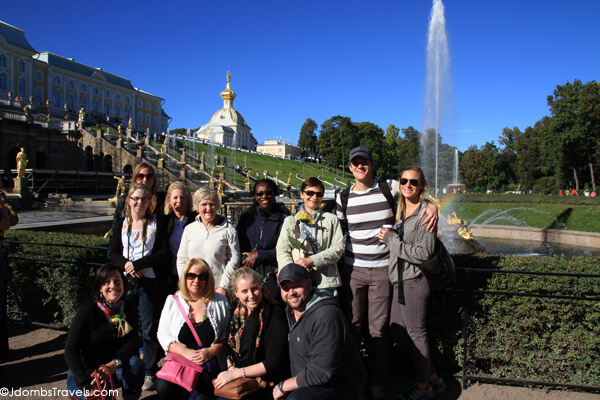
Our G Adventures group posing at Peterhof
1. Moscow has more billionaires per capita than anywhere else in the world.
Russia’s capital boasts more billionaire residents than any other city in the world – 79 to be exact, according to Forbes. Even without Forbes confirming, it’s easy to believe since we spotted just about every make of luxury car including more Rolls Royce’s than we’d even seen in Monaco.
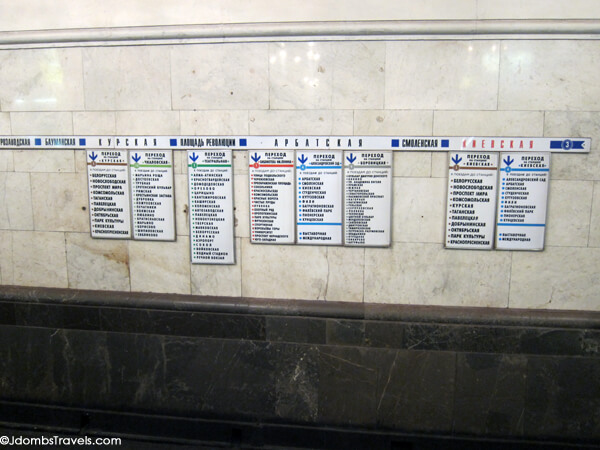
Loved these easy to use guides at each station!
2. Moscow has the 3rd busiest metro in the world.
Topping the list of the world’s busiest metros at number three, just behind Toyko and Seoul, there are 12 lines and more than 6 million people ride the Moscow Metro daily. Sound a bit intimidating? It was actually one of the easiest metros we’ve ever used and never had to wait more than 40 seconds between trains. There’s even a clock at each stop to time it!
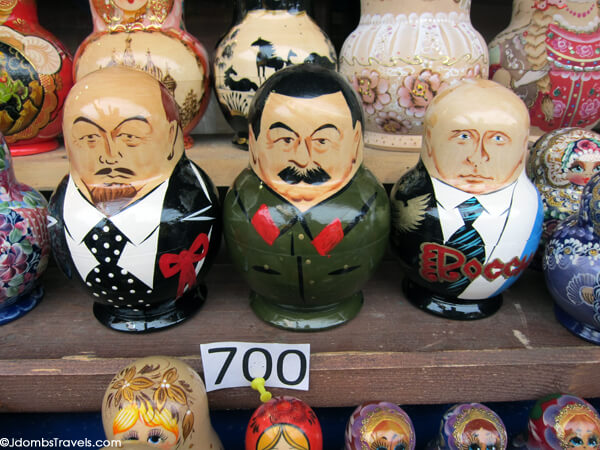
Scowling Russian Nesting Dolls
3. Russians are taught not to smile in school.
Russia regularly takes first place on lists of the World’s Least Friendly Countries. I personally think that Russians are just misunderstood. Our G Adventures CEO, Daria, told us that Russians are taught not to smile in school. And despite being met with scowls, most Russians were friendly and willing to help us translate or point us in the right direction when temporarily lost.
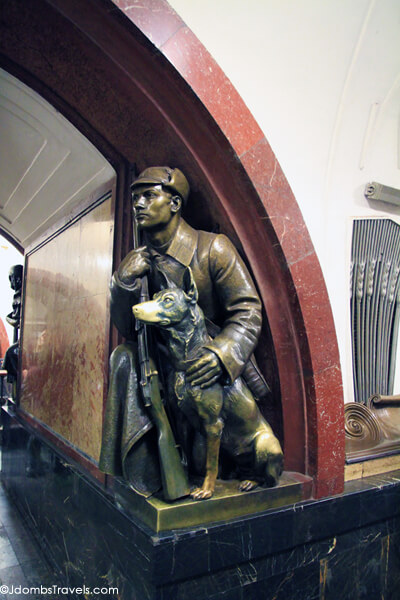
Rub the nose of the dog with your left hand to be blessed with riches
4. Russians have a lot of superstitions.
From rubbing a dog’s paw (but only with your left hand!) for money to making a wish if you could successfully toss a coin into Peter the Great’s boot, we learned about a lot of superstitions. But my favorite was how Russians selected where to build their homes in ancient times. Of course, it was a superstition that the first to enter a new house would die, so naturally they’d send a cat in first. They have nine lives after all! If the cat refused to enter, they’d tear down the structure and re-build somewhere else.
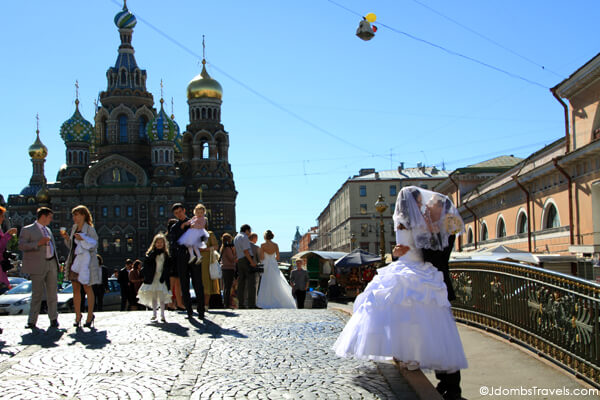
How many brides can you spot?
5. Russian brides go on a city tour after getting married.
I think we saw more Russian brides in 10 days traveling in Russia than I ever saw in 6 years of living in Las Vegas. We saw them posing in front of famous churches like St. Basil’s and Church of Our Savior on Spilled Blood, at parks, and even on boats along St. Petersburg’s canals. It’s tradition for a newly married couple to go on a city tour immediately following the ceremony.
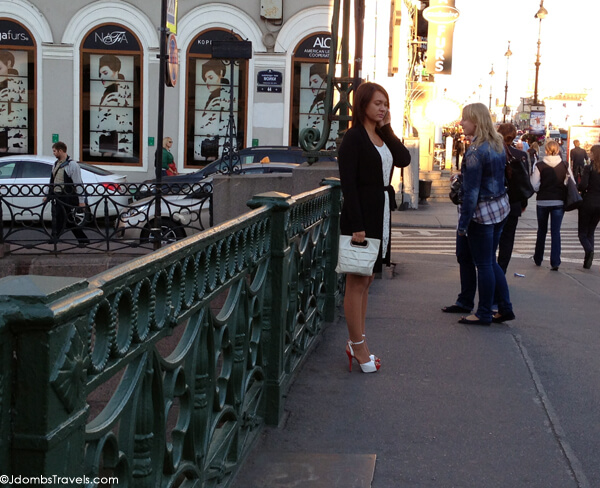
She walked for blocks in those shoes!
6. Russian women really do walk around in 6-inch heels.
Russia = the land of fabulous shoes. And Russian women never failed to amaze me as they traversed the cobbled streets in 6-inch stilettos, never faltering. Perhaps all the vodka numbs the feet?
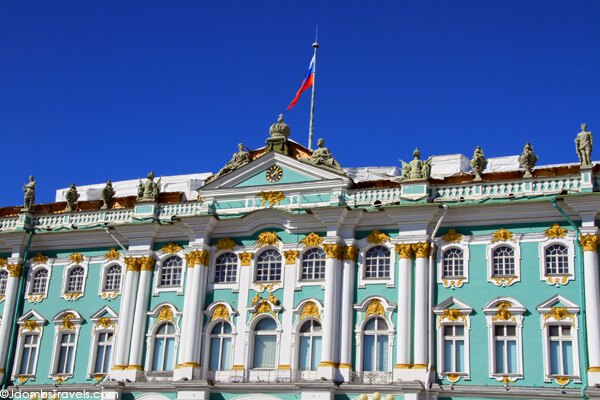
One building of the beautifully ornate Hermitage
7. If you spent 2 minutes looking at each exhibit in the Hermitage, it would take you 6 years to see everything.
The Hermitage is huge. Massive. Comprised of six buildings, there are over 3 million exhibits inside. It’s also one of the largest and oldest museums in the world and was founded by Catherine the Great in 1764.
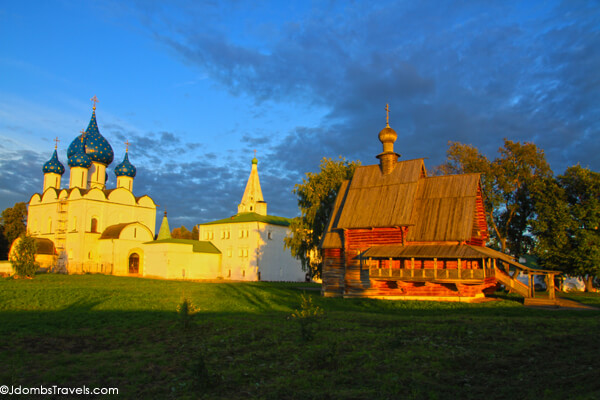
Kremlin and the wooden Church of St. Nicholas
8. The village of Suzdal is only 15 square kilometers but has an incredible 53 churches.
Suzdal is full of picturesque charm. Even though the population is now over 10,000, it retains its small village feel and charm. There is a beautiful juxtaposition between Russian architecture and farmland. The sun had broke through the clouds just in time for sunset and we literally frolicked in a meadow as the golden sun illuminated the Kremlin and wooden church of St. Nicholas.
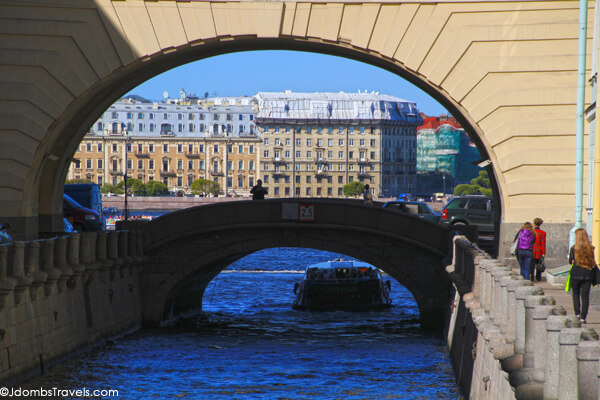
Standing on a bridge, taking a photo of a bridge
9. St. Petersburg has three times as many bridges as Venice.
Many cities – Bruges, Amsterdam, and Hamburg, to name a few – are all dubbed the “Venice of the North”. St. Petersburg is also on that list, and dare I say, is much more romantic than Venice itself. We had sunny days and the golden hour before sunset was our favorite time to wander the city. We’d pause on some of the city’s over 1000 bridges that cross the canals to watch golden onion domes glisten and spires sparkle.


